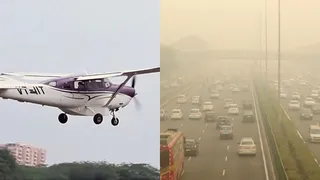- By Deeksha Gour
- Wed, 29 Oct 2025 12:32 AM (IST)
- Source:JND
Delhi Cloud Seeding: After more than five decades, Delhi conducted cloud seeding trials on Tuesday in an effort to generate artificial rain and reduce rising pollution levels in the capital. The Delhi government, in collaboration with IIT Kanpur, carried out the operation over Burari, North Karol Bagh, Mayur Vihar and Badli.
The India Meteorological Department (IMD) said no rainfall was recorded in the capital till late evening. However, a government report cited by PTI mentioned a marginal drop of about 10 per cent in PM 2.5 and PM 10 levels at the locations where the trials were conducted. Light showers of 0.1 mm and 0.2 mm were reported in Noida and Greater Noida.
Delhi Cloud Seeding: Why The Attempt Failed
The Delhi government’s report said the absence of adequate atmospheric moisture was the main reason behind the failure to induce rainfall. “The moisture content predicted by IMD and other agencies remained low at 10–15 per cent, which is not ideal for cloud seeding,” the report stated.
Before the seeding, the PM 2.5 levels were 221 in Mayur Vihar, 230 in Karol Bagh and 229 in Burari. After the exercise, these levels dropped slightly to 207, 206 and 203, respectively. Similarly, PM 10 levels reduced from an average of 207 to around 170.
The report also mentioned that while cloud seeding helped in reducing local particulate matter concentrations, the overall conditions were not conducive for sustained rainfall due to low humidity. Environmentalists described the initiative as a short-term measure that offers temporary relief but does not address the deeper causes of Delhi’s worsening air quality.
How The Cloud Seeding Trials Were Conducted In Delhi
According to officials, two rounds of cloud seeding were carried out on Tuesday. The first trial began around 2 PM and the second one took place at 4 PM using a Cessna aircraft that took off from Meerut. The plane was equipped with silver iodide and sodium chloride flares, each weighing between 2 and 2.5 kilograms, which were burned for about 18 minutes to create condensation in clouds.
The operation covered a corridor measuring approximately 25 nautical miles between Khekra and north of Burari, with flares released at altitudes of 4,000 to 6,000 feet. Despite the lack of significant rainfall, IIT Kanpur scientists expressed optimism, noting that the experiments were conducted systematically and yielded measurable reductions in pollution.
ALSO READ: Delhi Aims To Be Global Education Hub With DDA's Narela Project
The government said it plans to carry out up to 10 more such trials in the coming days, depending on weather conditions.
Delhi Cloud Seeding: AAP Reaction
The Aam Aadmi Party (AAP) mocked the exercise, calling it a publicity stunt rather than a scientific solution. AAP leaders alleged that the government was trying to “steal Lord Indra’s credit” instead of addressing the city’s long-standing pollution problems. The BJP, however, supported the initiative, calling it a “scientific and result-oriented” step to reduce pollution.
Meanwhile, Delhi’s air quality showed a slight improvement, with the AQI dropping from 301 (very poor) to 294 (poor).
(With Inputs From PTI)

